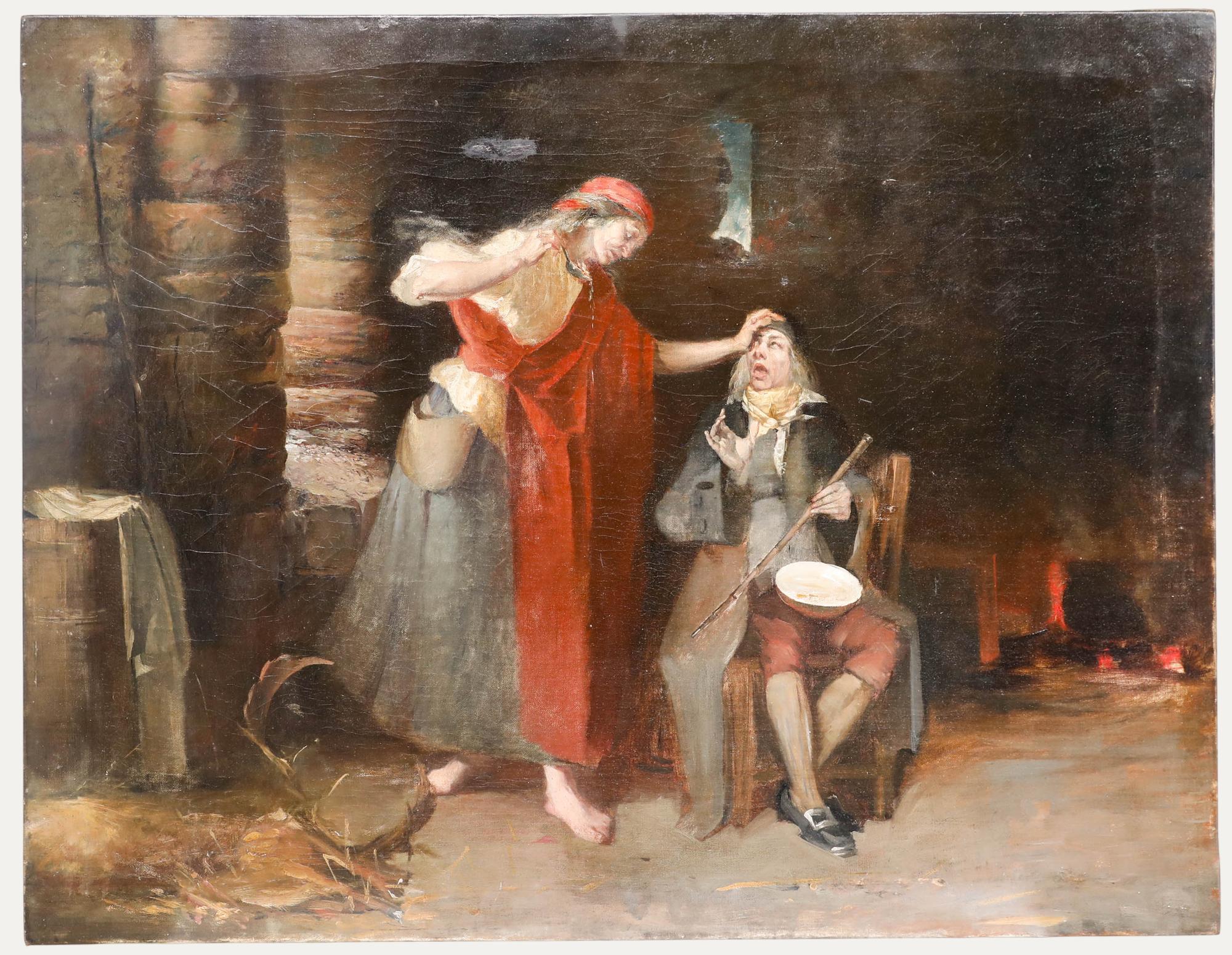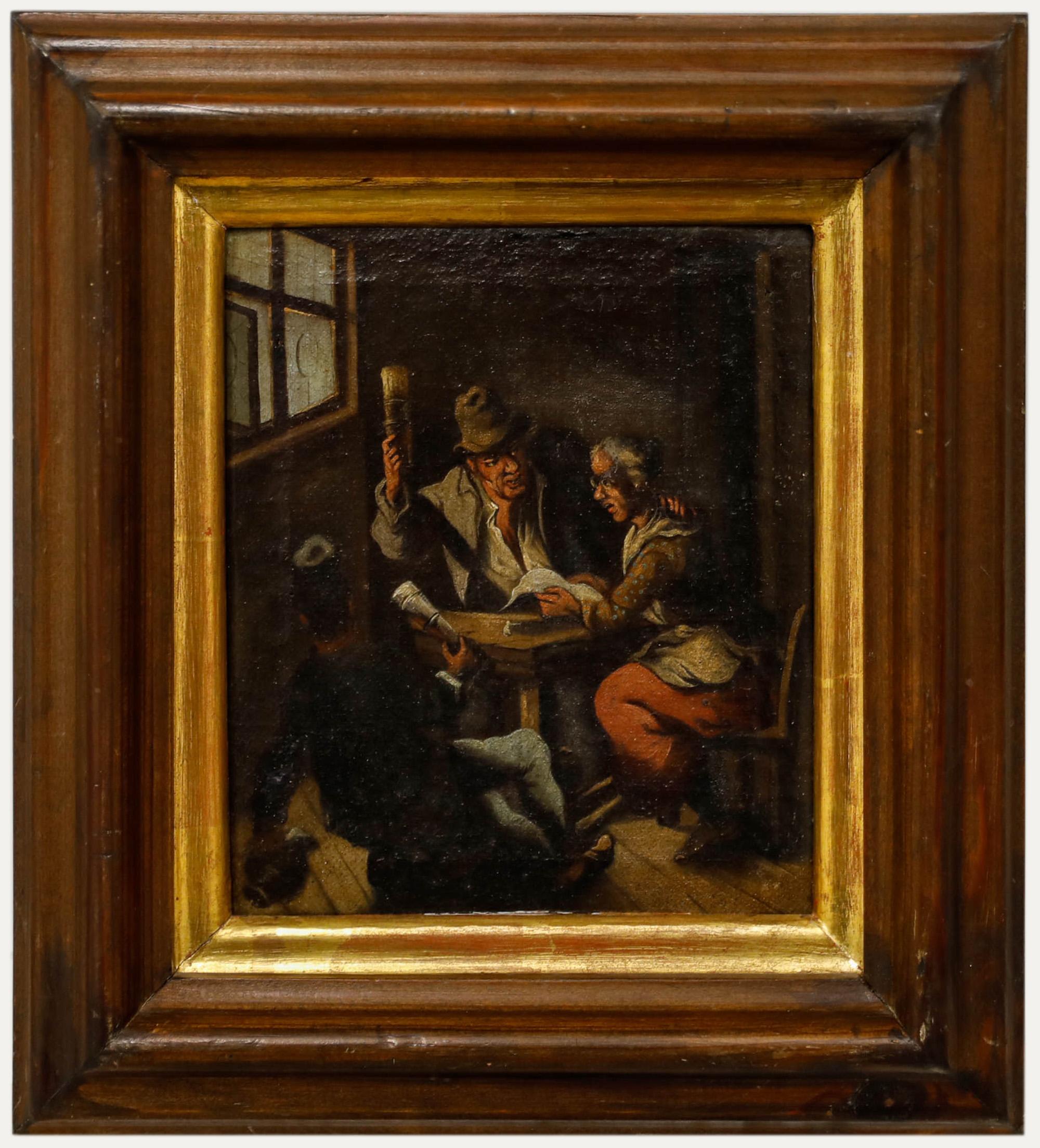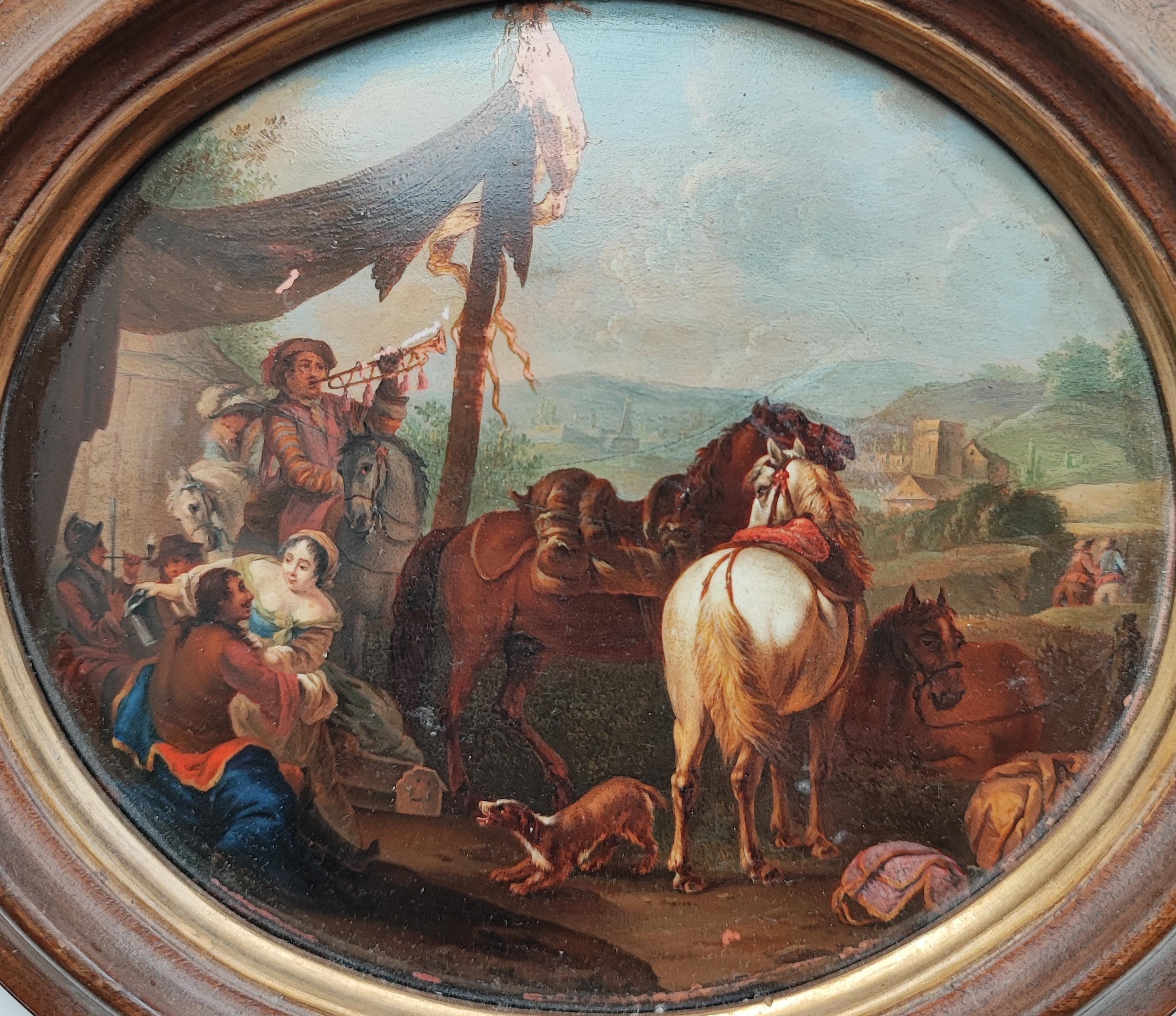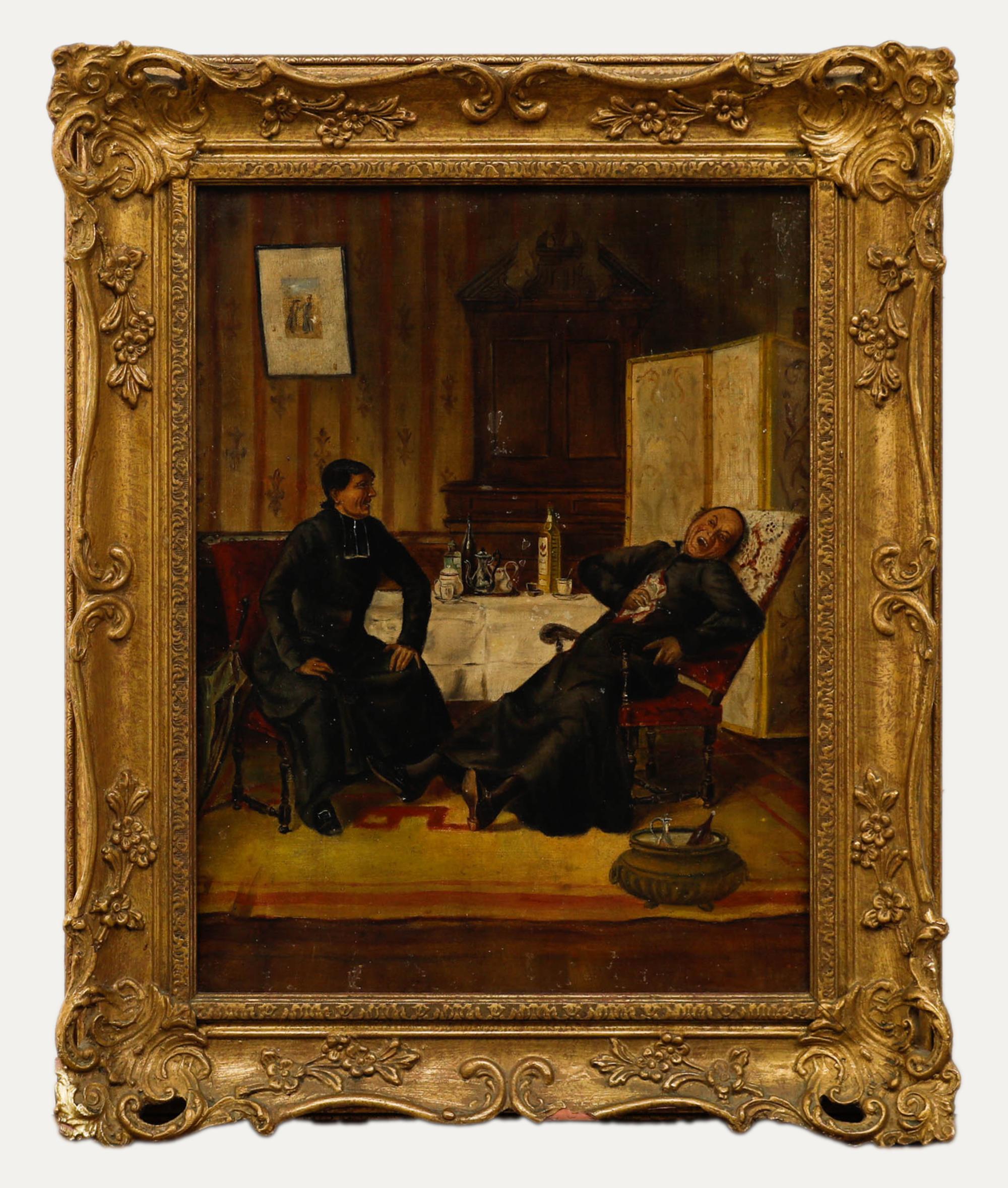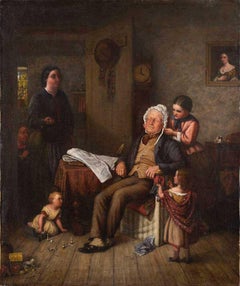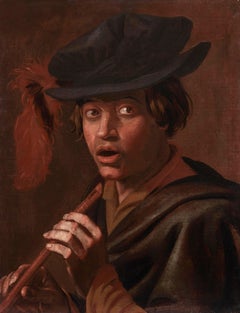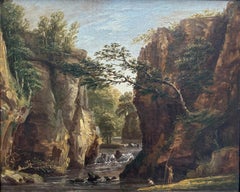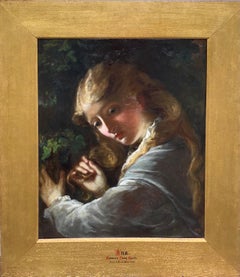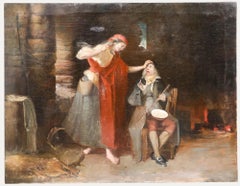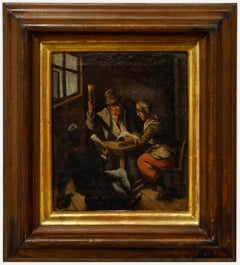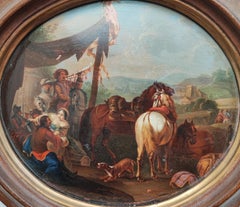Want more images or videos?
Request additional images or videos from the seller
1 of 2
17th Century Dutch SchoolAn Allegory for Smell
$11,711.67
£8,500
€10,058.98
CA$16,135.86
A$17,977.63
CHF 9,385.17
MX$218,272.39
NOK 117,965.51
SEK 111,506.06
DKK 75,089.08
About the Item
Dutch School
An Allegory for Smell
17th Century
Oil on canvas
Image size: 19 x 14.5 cm
Dutch ebonised frame
This painting depicts a rather smelly scene - a young boy bent over his father’s knee as the older man wipes the boy’s bottom. It appears the boy has had an accident on the toilet - positioned in the bottom left, with an unmistakable brown stain on the seat - and requires cleaning. Behind the father and son is the mother, drying a piece of fabric over the fire as she turns her head towards the scene as if she has just smelt the aftermath of the boy’s accident.
Dutch Golden Age paintings are renowned for their hidden symbolism, and this genre painting is no different. It reflects the popular painterly subject matter of depicting allegories for the five senses - scenes of exaggerated onslaughts against the senses of the painting’s subjects. The allegory in this painting is unsurprisingly one for the sense of smell - in fact, the image of a boy being cleaned after an accident was a stock representation for allegories for scent. With this in mind, the viewer can’t help but imagine the vulgar scent carried by the distinctive brown stains on the boy’s bottom and toilet, and how assaulting this smell would be. Additionally asserting the painting as an allegory for the sense of smell is the emphasis on the noses of the figures - the man’s bright red nose, and the woman’s bulbous one.
Despite its humorous subject matter, the painting is truly beautiful. The scene is cast in a low light that connotes a homely domestic interior, additionally emphasised by the proximity of each figure to one another. The boy’s bottom is fleshy, with accurate rolls and creases demonstrating a keen eye for anatomical detail. The face of the father stands out too, painted in pale tones that draw further attention to his scarlet nose. The depiction of the bunched fabric of the cleaning cloth and the boy’s garments also pay testament to the skill of the unknown painter behind this artwork.
- Creator:17th Century Dutch School
- Dimensions:Height: 7.5 in (19.05 cm)Width: 5.75 in (14.61 cm)
- Medium:
- Movement & Style:
- Period:
- Condition:
- Gallery Location:London, GB
- Reference Number:1stDibs: LU52416332332
About the Seller
5.0
Vetted Professional Seller
Every seller passes strict standards for authenticity and reliability
Established in 2007
1stDibs seller since 2014
82 sales on 1stDibs
Typical response time: 3 hours
- ShippingRetrieving quote...Shipping from: London, United Kingdom
- Return Policy
Authenticity Guarantee
In the unlikely event there’s an issue with an item’s authenticity, contact us within 1 year for a full refund. DetailsMoney-Back Guarantee
If your item is not as described, is damaged in transit, or does not arrive, contact us within 7 days for a full refund. Details24-Hour Cancellation
You have a 24-hour grace period in which to reconsider your purchase, with no questions asked.Vetted Professional Sellers
Our world-class sellers must adhere to strict standards for service and quality, maintaining the integrity of our listings.Price-Match Guarantee
If you find that a seller listed the same item for a lower price elsewhere, we’ll match it.Trusted Global Delivery
Our best-in-class carrier network provides specialized shipping options worldwide, including custom delivery.More From This Seller
View AllMischief, 19th Century British School Signed Oil
Located in London, GB
British School
19th Century
Mischief
Oil on canvas
Image size: 30 x 25 inches
Signed and inscribed indistinctly
Category
19th Century Figurative Paintings
Materials
Canvas, Oil
Price Upon Request
The Musician
Located in London, GB
This head and shoulders portrait is an outstanding example of the breadth, force and beauty of this artist's pictorial manner and abilities. This captivating portrait features a musi...
Category
Late 17th Century Portrait Paintings
Materials
Canvas, Oil
$15,431
The Gorge
Located in London, GB
Attributed to George Barret Sr
The Gorge
Oil on canvas
Image size: 13 1/2 x 16 1/2 inches (34.5 x 42 cm)
Gilt frame
In this landscape, a river runs over rocks at the bottom of a cra...
Category
18th Century Paintings
Materials
Canvas, Oil
Una
Located in London, GB
Richard Waller
1811 - 1882
Una
Oil on canvas, signed lower right and dated 1879
Image size: 23 1/2 x 19 1/2 inches (59.5 x 49.5 cm)
Original frame
Una is one of the main characters in the first book of Edmund Spenser...
Category
19th Century Victorian Portrait Paintings
Materials
Canvas, Oil
$7,440
Portrait of a Young Man
By (After) Rembrandt van Rijn
Located in London, GB
Pupil of Rembrandt
Portrait of a Young Man
17th Century
Oil on oak panel
Image size: 4 1/4 x 5 inches (11 x 13 cm)
Dutch ebonised frame
This small portrait is of a young man, staring inquisitively out towards the viewer. The realism of his appearance is striking, with great care taken in the depiction of the man’s features - for example, his full lips and the slight bump in the bridge of his nose. The man wears a rich burgundy doublet and a black cap and is adorned with gold accessories, indicating a degree of wealth - it is likely that this is a miniature portrait for a wealthy patron. The warm flesh tones of this painting and the intricate rendering of the man’s curly brown hair demonstrate the artistry of the painter, who has successfully captured the image of youth within his brushstrokes.
Rembrandt’s Pupils
Upon completing his artistic education, Rembrandt opened a studio and began to take students - the first of which were Gerrit Dou and Isaac Jouderville. The studio functioned as an art school, in which materials and guidance were provided - contrary to the studios of his peers, Rembrandt did not offer lodging to his pupils. The families of prospective pupils had to pay Rembrandt 100 guilders (enough for a house at the time) for this artistic education, and the profits from any works produced by pupils under Rembrandt would be paid to the master rather than kept by the student-artist - this contributed substantially to the master’s income.When taking on pupils, Rembrandt looked for those who could already paint, and guided their styles to reflect his. By choosing pupils who were somewhat experienced artists, Rembrandt had an array of painters that could be involved at any stage of assisting with the creation of his works - in this way, Rembrandt’s pupils often functioned as studio assistants as well. In order to perfect Rembrandt’s style, pupils would paint copies of their teacher’s works, sometimes adding their own distinct variations. They would use the same subjects and models as Rembrandt himself, and would accompany him on outdoor trips to paint nature and landscapes. The extensive copying and utilisation of same source materials has rendered Rembrandt’s work and the work of his pupils difficult to differentiate, even in the modern era.At least 50 pupils were taught by Rembrandt, with many continuing on to become his studio assistants. A few graduated into successful artists in their own right - for example, Govaert Flinck...
Category
17th Century Portrait Paintings
Materials
Oak, Oil, Panel
Ram and Small Lamb
By Mary Newcomb
Located in London, GB
Mary Newcomb
Ram and Small Lamb
1922-2008
Oil on panel, signed & dated twice lower left, signed and titled verso
Image size: 14 1/4 x 15 3/4 inches (36 x 40 cm)
Original frame
This ...
Category
20th Century Paintings
Materials
Oil, Panel
You May Also Like
19th Century Oil - The Reluctant Patient
Located in Corsham, GB
This intimate domestic scene depicts a woman in a red dress and white cap tending to a seated elderly man who struggled against her forceful nature.
Unsigned. On canvas.
Category
19th Century Figurative Paintings
Materials
Oil
Early 19th Century Oil - A Threatening Presence
Located in Corsham, GB
A charming early 19th-century genre scene depicting figures having an altercation in a tavern interior. Unsigned. Presented in a wooden frame with a gilt-painted inner window. On can...
Category
Early 19th Century Figurative Paintings
Materials
Oil
A Man Down and Out on His Luck
Located in Douglas Manor, NY
5106 Down and out oil on board by Westhayer 1957
Category
1950s Portrait Paintings
Materials
Oil
Rest
Located in Genève, GE
Work on wood
Brown wooden frame
16.5 x 19 x 1.6 cm
Category
Mid-19th Century Landscape Paintings
Materials
Oil
$1,163
The Rehearsal for Spontaneity
Located in Wilton Manors, FL
Artist Unknown
The Rehearsal for Spontaneity. 1990
Mixed Media on wood panel, 20 x 29.5 inches.
Unsigned and unattributed. Original label on verso. Frame has bee removed which e...
Category
1990s Figurative Paintings
Materials
Mixed Media, Wood Panel
19th Century Oil - Raucous Clerics
Located in Corsham, GB
This intimate scene depicts two clergymen in an interior, one seated upright while the other reclines, laughing uncontrollably. Unsigned. Presented in a swept gilt frame with pierced...
Category
19th Century Figurative Paintings
Materials
Oil
More Ways To Browse
Dutch Masters Paintings
17th Century Oil Paintings
Old Dutch Paintings
Allegory Paintings
Dutch School Oil Paintings
17th Century Figures
Dutch Paintings Old Master
Dutch Painting 17th Century
Dutch Oil Paintings 17th Century
Old Testament Paintings
Dutch Genre Paintings
Dutch Master Paintings 17th Century
Interior Painting 19 Century
Dutch Golden Age Painting
Dutch Woman Oil
17th Century Oak Panels
Dutch Boy
Golden Boy
